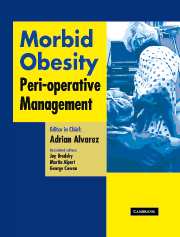Book contents
- Frontmatter
- Contents
- Contributors
- Foreword
- Preface
- Acknowledgments
- Dedication
- Section 1 General aspects
- Section 2 Pathophysiology
- Section 3 Pre-operative management
- Section 4 Peri-operative management of co-morbidities
- Section 5 Pharmacology
- Section 6 Monitoring
- Section 7 Intra-operative management
- Section 8 Post-operative care
- Section 9 Conclusions
- 30 Anesthesia and morbid obesity: present and future
- Afterword
- Index
30 - Anesthesia and morbid obesity: present and future
from Section 9 - Conclusions
Published online by Cambridge University Press: 17 August 2009
- Frontmatter
- Contents
- Contributors
- Foreword
- Preface
- Acknowledgments
- Dedication
- Section 1 General aspects
- Section 2 Pathophysiology
- Section 3 Pre-operative management
- Section 4 Peri-operative management of co-morbidities
- Section 5 Pharmacology
- Section 6 Monitoring
- Section 7 Intra-operative management
- Section 8 Post-operative care
- Section 9 Conclusions
- 30 Anesthesia and morbid obesity: present and future
- Afterword
- Index
Summary
Obesity a growing medical problem
Conclusions regarding the disease: morbid obesity
Obesity is a major healthcare problem, and the prevalence is increasing. Recently it has been informed that its prevalence has grown dramatically from 1996 to 2000, and is expected that it will rise to 40% by 2025. Actually 20% of patients have a body mass index (BMI) over 30, 2% over 40 and 0.25% over 50. Morbid obesity is a life-threatening situation in the long term and BMI over 40 if not treated, significantly shortens the individual's life expectancy.
The World Health Report for 2002 estimated that there were more than 2.5 million annual deaths due to weight-related problems, with 220,000 of those deaths in Europe and more than 300,000 obesity-related deaths in the US.
Deaths between the obese population are principally caused by coronary heart disease, stroke and diabetes mellitus, although sudden unexplained death, malignancies and fatal accidents are also more prevalent when compared with lean people. It has been shown that there is a 12-fold excess mortality in men in the age group 25–34 years and a 6-fold in those aged 35–44 years. In addition, the prevalence and severity of co-existing diseases has shown a clear correlation with the duration of obesity, therefore, it is advisable to provide a successful weight reduction treatment as early in the patient's life as possible.
- Type
- Chapter
- Information
- Morbid ObesityPeri-Operative Management, pp. 399 - 406Publisher: Cambridge University PressPrint publication year: 2004

